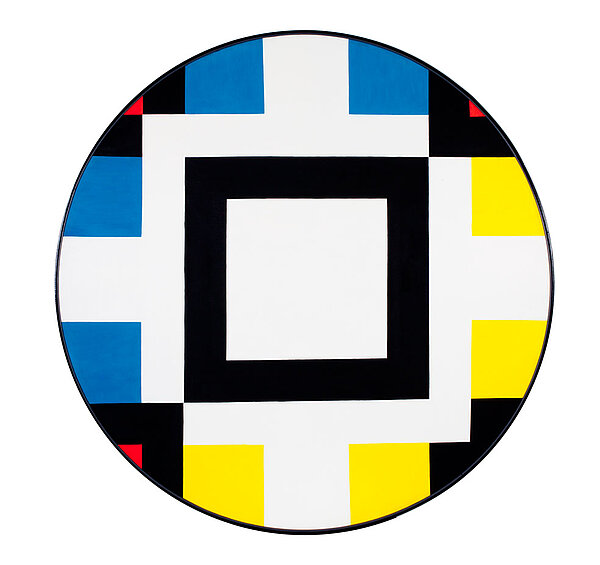Leon Polk Smith
Diagonal Passage, 1947
Oil on canvas
Ø 147 cm
© VG Bild-Kunst, Bonn 2022
Photo: Gerhard Sauer
When Leon Polk Smith arrived in 1936 in New York for a post-graduate course as art educationalist, he visited the Albert E. Gallatin Gallery of Living Art and for the first time encountered works by Piet Mondrian, Constantin Brancusi and Hans Arp. This discovery of European Modernism and above all Dutch Neoplasticism was to have a lasting impact on the budding artist, although he continued at first to do figurative painting until 1940. Smith was to remain intimately connected with the city of New York for the rest of his life; here he soaked up the latest movements in the art world and worked for Hilla Rebay, the director of the Museum of Non-Objective Painting who championed the art of the European avant-gardes. Smith also kept up a lively exchange with his fellow artists, without however taking part in initiatives such as the association of American Abstract Artists, which was founded in 1936.
The painting Diagonal Passage conveys Smith’s ongoing preoccupation with the art of the De Stijl movement during the 1940s. Although he refused to adopt Piet Mondrian’s theoretical principles for his own output, the creative principles of Neoplasticism have clearly been brought to bear in many ways on this work. Through his choice of a circular format, Leon Polk Smith set himself distinctly apart from his artistic forebears, although he no doubt knew the works of the Swiss painter Fritz Glarner, who was friends with Mondrian, and who was busy at that time producing a suite of works in New York that linked the tondo or circular form with constructive elements. Similarly, Leon Polk Smith’s painting is dominated by an orthogonal structure and a combination of the three primary colours together with black and white. Unlike the always expansive style developed by Glarner, who was seven years older, Smith’s piece underlines the hermetic aura of the disk with a large square at its centre, surrounded by a black outline. Against this, the arrangement of the blue and yellow sections along an imaginary diagonal axis, together with the asymmetrical distribution of the red tone, add a certain looseness to the closed entity formed by square and circle.
Leon Polk Smith’s particular adaptation of Neoplasticism can be viewed in the context of his cultural background, for doubtless his Cherokee heritage left a strong mark on his artistic work. The emphasis on the centre of the image, as well as the striking relationship between the black elements and the white sections, echo the striking patterns found in First Nations’ arts and crafts. (Hsiaosung Kok)
Leon Polk Smith
1906 born in Chickasha, Indian Territory (today: Oklahoma)
1996 died in New York


